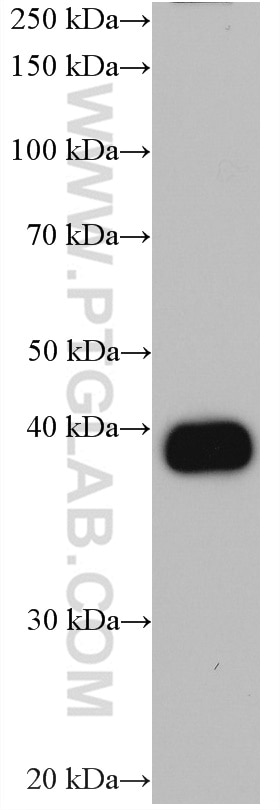Validation Data Gallery
Tested Applications
| Positive WB detected in | human saliva tissue |
Recommended dilution
| Application | Dilution |
|---|---|
| Western Blot (WB) | WB : 1:1000-1:5000 |
| It is recommended that this reagent should be titrated in each testing system to obtain optimal results. | |
| Sample-dependent, Check data in validation data gallery. | |
Product Information
66909-1-Ig targets Carbonic Anhydrase 6/CA6 in WB, ELISA applications and shows reactivity with human samples.
| Tested Reactivity | human |
| Host / Isotype | Mouse / IgM |
| Class | Monoclonal |
| Type | Antibody |
| Immunogen | Carbonic Anhydrase 6/CA6 fusion protein Ag24274 相同性解析による交差性が予測される生物種 |
| Full Name | carbonic anhydrase VI |
| Calculated molecular weight | 35 kDa |
| Observed molecular weight | 38 kDa |
| GenBank accession number | BC034350 |
| Gene Symbol | CA6 |
| Gene ID (NCBI) | 765 |
| RRID | AB_2882236 |
| Conjugate | Unconjugated |
| Form | Liquid |
| Purification Method | Antigen affinity purification |
| UNIPROT ID | P23280 |
| Storage Buffer | PBS with 0.02% sodium azide and 50% glycerol , pH 7.3 |
| Storage Conditions | Store at -20°C. Stable for one year after shipment. Aliquoting is unnecessary for -20oC storage. |
Background Information
CA6 (Carbonic anhydrase VI ) is a member of CA family proteins that play a central role in pH regulation and electrolyte balance. CA6 is also known as gustin, is a zinc-containing secreted protein which catalyzes the hydration of carbon hydroxide in saliva. CA6 is specifically expressed in the salivary gland of a number of mammalian species (PMID:28423504). The amino acid sequences are highly conserved across the species. And it was reported that decreasing of CA6 protein was associated with loss of taste and pathological morphology of taste buds (PMID: 9784398).
Protocols
| Product Specific Protocols | |
|---|---|
| WB protocol for Carbonic Anhydrase 6/CA6 antibody 66909-1-Ig | Download protocol |
| Standard Protocols | |
|---|---|
| Click here to view our Standard Protocols |
